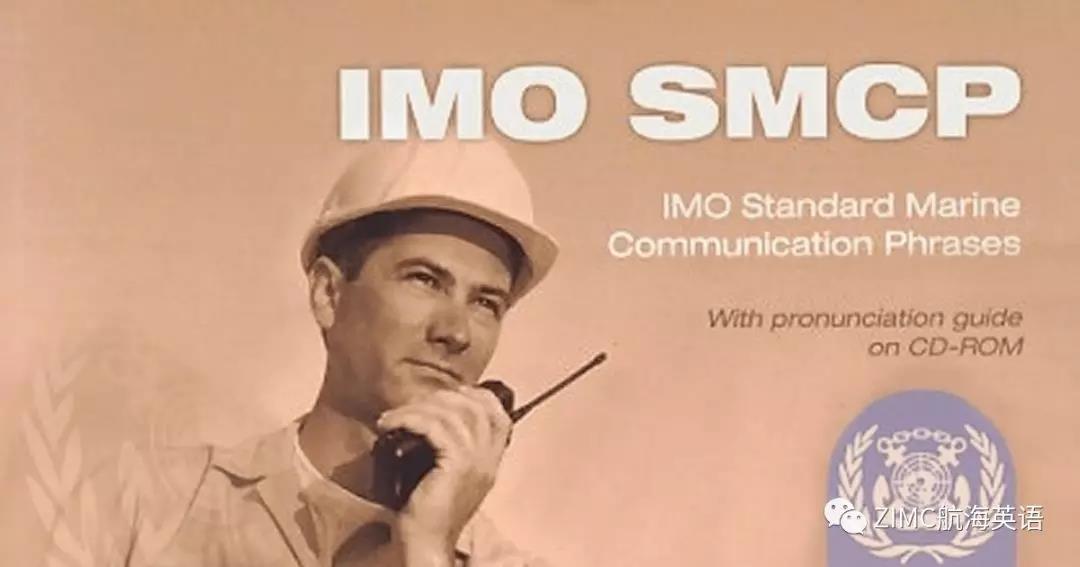IMO标准通信英语入门
2019-12-20 15:02
来自:ZIMC航海英语

《IMO标准海事通信用语》
总 则 General
1. 拼读 Spelling
Letter | Code Word | Letter | Code Word |
A | Alfa | N | November |
B | Bravo | O | Oscar |
C | Charlie | P | Papa |
D | Delta | Q | Quebec |
E | Echo | R | Romeo |
F | Foxtrot | S | Sierra |
G | Golf | T | Tango |
H | Hotel | U | Uniform |
I | India | V | Victor |
J | Juliet | W | Whiskey |
K | Kilo | X | X-ray |
L | Lima | Y | Yankee |
M | Mike | Z | Zulu |
打开App,看更多相似信息
2. 信文标识 Message Markers
在岸—船和船—岸通信中或一般的无线电通信中,可使用下述八个信文标识。
(1)指示 Instruction
(2)建议 Advise
(3)警告 Warning
(4)信息 Information
(5)询问 Question
(6)回答 Answer
(7)请求 Request
(8)意图 Intention
3. 回答 responses
3.1 如果对问题的回答是肯定的,应说“是的”,后接完整语句。
―Yes, …
3.2 如果对问题的回答是否定的,应说“不”,后接完整语句。
―No, …
3.3 如果对需求的信息不能立即提供,可说“请稍等”,后接信息可适用的时间间隔。
―Stand by …
3.4 如果不能获得对方需求的信息,可说“没有信息”。
―No information.
3.5 当由交管站、海军船舶或其他授权人士给出指令(INSTRUCTION)或建议(ADVISE)时,如果给予肯定的回答,则说“我将/能...”,后接完整的指令或建议。如果是否定的回答,则说“我将不/不能...”,后接完整的指令或建议。
—I will/ can …
―I will not/ cannot …
例如:“建议。不得追越你北面的船。”
―ADVISE. Do not overtake the vessel to the North of you.
回答:“我不会追越我北面的船。”
―I will not overtake the vessel to the North of me.
3.6在对外通信和船舶内部通信中,应答命令和对特别重要问题的回答,应使用标准用语中的语句。
4. 遇险/紧急/安全信文 Distress/ Urgency/ Safety signals
4.1 MAYDAY用于发布遇险信文。
MAYDAY to be used to announce a distress message.
4.2 PAN-PAN用于发布紧急信文。
PAN-PAN to be used to announce an urgency message.
4.3 SECURITE用于发布安全信文。
SECURITE to be used to announce a safety message.
5. 标准组织用语 Standard organizational phrases
5.1 “你收听(我)的声音怎样?”
―How do you read (me)?
我收听你的声音„
I read you …
很差/1 信号强度为1(即极弱)
bad/ with signal strength one
很弱/2 信号强度为2(即很弱)
Poor/ with signal strength two
还好/3 信号强度为3(即还好)
fair/ with signal strength three
较好/4 信号强度为4(即较好)
good/ with signal strength four
很好/5 信号强度为5(即很好)
excellent/with signal strength five
5.2 当建议保持在某个VHF频道/频率上时,说:“请在VHF频道.../频率...上守听”。
―Stand by on VHF channel …/ frequency ….
5.2.1 当同意保持在指定的VHF频道/频率上时,说:“在VHF频道.../频率...上守听”。
―Standing by on VHF channel …/ frequency ….
5.3 当建议转到另一VHF频道/频率上时,说:“请转到VHF频道.../频率...”。
―Advise (you) change to VHF channel …/ frequency ….
5.3.1 当同意转到某VHF频道/频率接收时,说“转到VHF频道.../频率...”。
―Changing to VHF channel …/ frequency ….
6. 改正 Corrections
当信文出现错误时,说:“错误”。随后说:“改正”加上信文正确部分。
―… mistake. Correction…
例如:“我现在的速度为14节,错误。改正,我现在的速度是12节,十二节。”
―My present speed is 14 knots –mistake. Correction, my present speedis 12 knots, one-two, knots.
7. 准备 Readiness
“我准备/还没准备好接收你的信文。”
―I am/ I am not ready to receive your message.
8. 重复 Repetition
8.1 如果认为信文的某部分非常重要,为确保无误,可说:“重复”随后是信文的相应部分。
―Repeat…
例如:“我的吃水为12.6,重复,12.6米”
―My draft is 12.6, repeat, one-two decimal six meters.
8.2 如果信息没有确切听到,说:“请再说一遍”。
―Say again (please).
9. 数字 Numbers
0
zero
10
ten
20
twenty
1
one
11
eleven
21
twenty-one
2
two
12
twelve
22
twenty-two
3
three
13
thirteen
30
thirty
4
four
14
fourteen
40
forty
5
five
15
fifteen
50
fifty
6
six
16
sixteen
60
sixty
7
seven
17
seventeen
70
seventy
8
eight
18
eighteen
80
eighty
9
nine
19
nineteen
90
ninety
“百”用“hundred” 例如:256 (twohundred and fifty-six)
“千”用“thousand” 例如:1,361(one thousand threehundred and sixty-one)
“百万”用“million” 例如:952,000,000 (nine hundred andfifty-two million)
“十亿”用“billion” 例如:1,400,000,000 (one billion andfour hundred million)
通信中数字可逐位读出:
150 应读作:“一五零”(One-five-zero),
2.5 应读作:“二点五”(Two decimal five或者Two point five)
注:注意!当读舵角即舵令时,应按下列示例: 15,读“十五”(Fifteen);20读“二十” (Twenty); 25读“二十五”(Twenty-five)
10. 距离 Distance
距离用海里(nautical miles)或链 (cables)表示,所使用的单位必须加以注明。
11. 位置 Position
11.1 在使用经纬度时,应以度degrees、分minutes(如果需要,可以用分的小数decimal/point)来表示,并应标出北纬(N-north)或南纬(S-south),东经(E-east)或西经(W-west)。
例如:我的位置在22°04′N,127°08′E。
—My position is 22(two two) degrees 04(zerofour) minutes north, 127(one two seven) degrees 08(zero eight) minutes east.
注意:坐标 coordinate
经度 longitude
纬度 latitude
11.2 当位置相对于某一标志时,该标志必须是海图上明确标出的物标,方位应以由物标位置的真北起算,以360°记法来表示。
例如:“你的位置在花鸟山灯塔137°,距离2.4海里。”
Your position is bearing 137 degrees from Huaniaoshan lighthouse,
distance 2.4 nautical miles.
12. 方位 Bearing
除相对方位外,物标或船舶的方位是用由真北(除非另有说明)起算,以360°记法来表示。方位可从物标起算,也可以从船舶起算。
例如:“引航船在你船的215°方位上”
―Pilot boat is bearing 215 degrees from you.
13. 航向 Course
航向总是采用由真北(除非另有说明)起算,以360°记法来表示。可说明是驶往物标的航向,还是驶离物标的航向。
例如:我船的航向是125度。
—My course is one two five degrees.
14. 速度 Speed
速度用节(knots)表示。
例如:我船速度15节。
—My ship’s speed is 15 knots.
14.1 若无其他说明,则表示是相对于水的速度(speed through the water)。
14.2 “对地速度”表示相对于海底的速度(speed over the ground)。
15. 时间 Time
时间应以协调世界时(UTC)24小时来表示,如果在港内使用地方时应清楚指明。
例如: 1630 hours (one- six- three-zero hours或者sixteen- thirty) UTC
注:如果是当地时间,使用local time。
海上常用句型
1. Good morning.
早上好。
2. Good evening.
晚上好。
3. Welcome to Zhoushan.
欢迎到舟山来。
4. Have a good journey.
祝一路顺风。
5. Thank you for your cooperation.
谢谢合作。
6. Nice to meet you.
很高兴见到你。
7. PAN-PAN,PAN-PAN, PAN-PAN, MV Dongfang, this is MV Haiyun calling, over.
PAN-PAN, PAN-PAN,PAN-PAN, 东方轮,海运轮正在呼叫。
8. My main engine is in failure and startsdrifting.
我船主机故障,开始漂流。
9. My position is 22°04′N, 127°08′E.
我船的位置是在22°04′N, 127°08′E。
10. Keep well clear of me.
请让清我船。
11. Do you need any assistance?
你需要援助吗?
12. So far, no need. Thank you.
目前不需要。谢谢。
13. I need tugs.
我船需要拖轮。
14. MAYDAY, MAYDAY,MAYDAY, MV Dongfang, this is MV Haiyun calling, over.
MAYDAY, MAYDAY, MAYDAY, 东方轮,海运轮正在呼叫。
15. I am on fire.
我船着火了。
16. I am aground.
我船搁浅了。
17. I am in collision with MV Dongfang.
我船与东方船相撞了。
18. I am listing to port/starboard.
我船正在向左/右倾斜。
19. I am sinking.
我船正在下沉。
20. I require a helicopter.
我船需要直升机。
21. I will abandon the ship.
我将弃船。
22. I am on your port side.
我船在你的左舷。
23. I am on your starboard side.
我船在你的右舷。
24. I am ahead of you.
我船在你前方。
25. I am astern of you.
我船在你后方。
26. What is your intention?
你船的意图是什么?
27. I am entering the port.
我船正在进港。
28. I am anchoring.
我船抛锚。
29. I am crossing your course.
我船与你船航向交叉。
30. There is a fishing vessel on my portside.
我船左舷有一艘渔船。
31. The other vessel is 1.5 miles to port.
他船在左舷1.5海里处。
32. Keep to the starboard side of thechannel.
保持在航道右侧。
33. There is a risk of collision.
有碰撞危险。
34. There is no danger.
没有危险。
35. We are meeting head-on.
我们两船处于对遇。
36. Alter course to port.
向左转向。
37. Alter course to starboard.
向右转向。
38. Pass port to port.
左对左通过。
39. Pass starboard to starboard.
右对右通过。
40. Reduce speed. / Slow down.
减速。
41. Stop engine.
停车。
42. I am backing down/ reversing engine.
我船正在后退/倒车。
43. Keep your course and speed.
保持你的航向和航速。
44. Do not cross ahead of me.
不要从我前方穿越。
45. I intend to overtake you on your port side.
我船打算从你船左舷追越。
46. I intend to overtake you on your starboard side.
我船打算从你船右舷追越。
47. I am past and clear.
我船已驶过让清。
p.s. 以上部分内容来源于《IMO标准海事通信用语》和网络